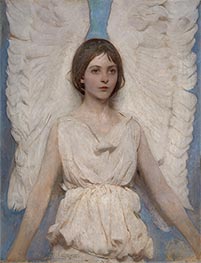
Abbott Handerson Thayer Painting Reproductions 1 of 1
1849-1921
American Symbolist Painter
Abbott Handerson Thayer was one of those rare artists who refused to fit neatly into any category. Born in 1849 in rural New Hampshire, Thayer grew up surrounded by nature - an early love for birds and wildlife would profoundly influence his work throughout his life. His childhood was spent not with paintbrushes, but with traps and taxidermy, immersed in the rawness of the natural world. But art was never far behind. By his teenage years, he had moved to Boston to study, honing his skills in depicting animals and landscapes. It was clear from the start that Thayer’s interests lay beyond traditional portraiture or grand allegories - he was captivated by life itself, particularly the creatures that inhabited the world around him.
Thayer’s art training took him to New York and Paris, where he rubbed shoulders with some of the most important artists of his day. Yet, unlike many of his peers, Thayer didn’t chase the glamorous life. He didn’t just paint to capture beauty - he painted to reveal deeper truths, to explore the essence of form and life. His "angel" paintings, often featuring his own children, are perhaps his most famous works. These figures, draped in white, adorned with wings, seem to float between earthly reality and some higher plane. In these images, Thayer wasn’t simply crafting religious or allegorical scenes - he was searching for something more profound, something eternal.
But Thayer was not merely a painter of angels and ethereal visions. He was a man deeply concerned with the physical world and its mysteries. Together with his son, Gerald, Thayer spent years studying protective coloration in nature, ultimately publishing "Concealing-Coloration in the Animal Kingdom". This wasn’t just a scientific curiosity - it was an obsession. Thayer believed that all animal coloration served a cryptic purpose, a theory that famously drew the ire of Theodore Roosevelt. While Thayer’s ideas on camouflage might have been extreme, they did have an impact on military camouflage during World War I, and his studies have left a lasting mark on the field.
Thayer’s later years were a mix of artistic brilliance and personal tragedy. He lost two of his children in the 1880s, and his first wife, Kate, followed soon after. Emotionally shattered, he returned to his beloved New Hampshire, where he lived the rest of his life in seclusion. His second marriage brought some peace, but Thayer’s eccentricities grew with age. He was known for his strong opinions, his unconventional teaching methods, and his insistence on sleeping outdoors year-round for the supposed health benefits. His mental health, however, was fragile - Thayer struggled with what we now recognize as bipolar disorder, and his bouts of depression often crippled his ability to work. Yet, despite these personal challenges, Thayer’s legacy endures. His art, imbued with both spiritual and earthly resonance, remains a testament to his singular vision of the world.
Thayer’s art training took him to New York and Paris, where he rubbed shoulders with some of the most important artists of his day. Yet, unlike many of his peers, Thayer didn’t chase the glamorous life. He didn’t just paint to capture beauty - he painted to reveal deeper truths, to explore the essence of form and life. His "angel" paintings, often featuring his own children, are perhaps his most famous works. These figures, draped in white, adorned with wings, seem to float between earthly reality and some higher plane. In these images, Thayer wasn’t simply crafting religious or allegorical scenes - he was searching for something more profound, something eternal.
But Thayer was not merely a painter of angels and ethereal visions. He was a man deeply concerned with the physical world and its mysteries. Together with his son, Gerald, Thayer spent years studying protective coloration in nature, ultimately publishing "Concealing-Coloration in the Animal Kingdom". This wasn’t just a scientific curiosity - it was an obsession. Thayer believed that all animal coloration served a cryptic purpose, a theory that famously drew the ire of Theodore Roosevelt. While Thayer’s ideas on camouflage might have been extreme, they did have an impact on military camouflage during World War I, and his studies have left a lasting mark on the field.
Thayer’s later years were a mix of artistic brilliance and personal tragedy. He lost two of his children in the 1880s, and his first wife, Kate, followed soon after. Emotionally shattered, he returned to his beloved New Hampshire, where he lived the rest of his life in seclusion. His second marriage brought some peace, but Thayer’s eccentricities grew with age. He was known for his strong opinions, his unconventional teaching methods, and his insistence on sleeping outdoors year-round for the supposed health benefits. His mental health, however, was fragile - Thayer struggled with what we now recognize as bipolar disorder, and his bouts of depression often crippled his ability to work. Yet, despite these personal challenges, Thayer’s legacy endures. His art, imbued with both spiritual and earthly resonance, remains a testament to his singular vision of the world.
1 Abbott Handerson Thayer Paintings

Angel 1887
Oil Painting
$1119
$1119
Canvas Print
$71.64
$71.64
SKU: AHT-18560
Abbott Handerson Thayer
Original Size: 92 x 71.5 cm
Smithsonian American Art Museum, Washington, USA
Abbott Handerson Thayer
Original Size: 92 x 71.5 cm
Smithsonian American Art Museum, Washington, USA